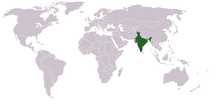MusikAnimal (talk | contribs) m Protected Portal:India/Intro: Persistent vandalism ([Edit=Allow only autoconfirmed users] (expires 16:10, 2 July 2014 (UTC))) |
|
(No difference)
| |
Revision as of 16:10, 25 June 2014
 |
 |

|
The Republic of India is a country that occupies a greater part of the Indian subcontinent. It borders Pakistan in the northwest, the People's Republic of China, Nepal, and Bhutan in the north, and Bangladesh and Myanmar in the east. India's coastline stretches for over seven thousand kilometers. Its neighbours in the Indian Ocean are the island nations of the Maldives in the southwest, Sri Lanka in the south, and Indonesia in the southeast. India is the second most populated country in the world, with a population of over one billion and is the seventh largest country by geographical area. It is a constitutional republic consisting of twenty eight States and seven union territories. The word India derives from the Old Persian cognate for the Sanskrit word Sindhu, the Indus river. The Constitution of India also recognizes Bhārat as an official name with equal status.
A centre of important historic trade routes, India is the home to some of the most ancient civilisations. India is the birthplace to three world religions:Jainism, Sikhism and Hinduism. It also has the largest Muslim population in the world after Indonesia and Pakistan. Hinduism is the major religion followed in India. India is a secular country. India was a former colony of the British Empire under the British Raj before gaining independence on 15 August 1947. The country has witnessed significant economic and military growth after the liberalization of the Indian economy. India is also well known for upholding the concept of peace, as was demonstrated by its peaceful method of freedom struggle.